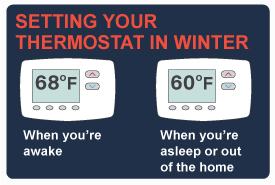
The U.S. Environmental Protection Agency estimates the average households spend about $1,100 annually on heating and cooling costs. By pairing annual HVAC maintenance with a programmable thermostat, you’ll lower your energy costs and feel cozy despite winter temperatures. The thermostat is great for individuals who are away from their homes for set periods, as well as those who don’t want the hassle of remembering to turn down the temperature before going to bed. Using the right device for your home can save you significantly on your electricity costs.
How Programmable Thermostats Work
Programmable thermostats have a small computer in them that track the day, time and temperature. Once programmed, they automatically maintain specific temperatures in your home throughout the day. Many also have an “away,” or “vacation,” setting that helps conserve energy when you’re gone for an extended period by maintaining a lower temperature.
Most programmable thermostats have touch screens that walk you through the programming process. Many also have an override, or “hold,” functions in the event you want to alter the temperature for a short period.
The Best Programmable Thermostat for Your Portland Home
The best thermostat for your home depends on your needs. There are three basic models from which to choose:
- 5+2-day model: This model allows you to set one schedule for weekdays and one for weekends.
- 5-1-1 model: Similar to the 5+2-day model, this thermostat allows you to set one schedule for weekdays, one for Saturday, and a different one for Sunday.
- 7-day model: This model is best if your heating needs differ daily because you can set different programs for each day. Some models allow you to program as many as four temperature periods (wake, day, evening, sleep) per day.
It’s important to keep in mind that there is no one-size-fits-all solution when it comes to heating and cooling your home with programmable thermostats. Features to consider when purchasing a thermostat include:
- Automatic changeover switch: Automatically switches between heating and cooling settings. This is great for areas that experience warm days and cool nights.
- Adjustable cycle: In general, thermostats with adjustable cycles prevent HVAC systems from cycling on and off frequently.
- Intuitive controls and easy-to-read screens: A programmable thermostat should be simple for you to program and read. Not only do these features make you more likely to use the device, they also help prevent energy-wasting mistakes.
- Save: A thermostat with a full memory save function saves the programs you created so you don’t have to re-enter them after a power outage.
- Remote access: “Smart” programmable thermostats allow you to program and control the device using a smartphone, tablet or computer with an Internet connection and the corresponding app. Some use multiple sensors to monitor temperatures in your home. Higher-end models may even detect and adjust temperatures in occupied rooms. A manufacturer may collect data based on your energy usage to recommend a heating schedule. It’s important to note that not all smart thermostats work with existing HVAC systems.
- Filter reminder: Changing the HVAC system’s filter regularly helps keep the system in top shape and prevents unnecessary wear and tear. Programmable thermostats with filter-change reminders alert you to when it’s time to change the filter based on elapsed time. The alerts are generally larger flashing messages on the control panel. Smart models may send an alert to your device or email.
Benefits of Smart Thermostats
At the time of publication, popular thermostat manufacturers include Nest, Hive, Honeywell, Ecobee4, Starck and Tado. The devices learn your habits and adjust the temperatures in your home based on your habits.
As a bonus, some models also work with other smart gadgets to enhance your experience, take the outside weather into consideration, or use geolocation to track your whereabouts and ensure your home feels comfortable by the time you arrive.
Rather than pay full price for a smart thermostat, some brands offer subscription plans that allow you to rent the device for a more affordable monthly fee.
Recommended Thermostat Settings for Portland’s Winter Temperatures
The EPA recommends the following set-point temperatures during the winter to maximize your energy savings:

- Wake (the time you wake up): 70°F or cooler
- Day (the time you leave for work, school or other activities): set the temperature back at least 8°F cooler than the “wake” set-point temperature
- Evening (the time you return home): 70°F or cooler
- Sleep (the time you go to bed): set the temperature back at least 8°F cooler than the “evening” set-point temperature
When you program set-point temperatures, the thermostat will automatically turn up the heat a bit earlier than the time you indicate so your home feels comfortable when you wake up and return home. Programming the thermostat so your home is 8°F to 15°F cooler while you’re asleep and out of the house will help save between 5 and 15 percent on your heating bill. Lowering the temperature more could waste energy because the system has to work harder to reach the temperature you desire.
If you’ve never used a programmable thermostat, the EPA has a virtual thermostat you can play with to get a feel for how one works. To determine the right type of programmable thermostat for your heating and cooling system, get in touch with AAA Heating and Cooling. Our specialists will pair you with a model that best meets your needs, recommend the best temperature settings, and show you how to program it. Schedule a visit today.